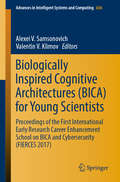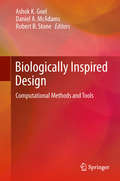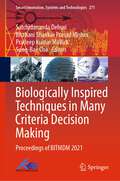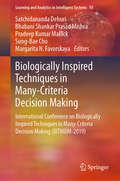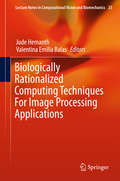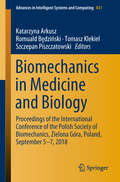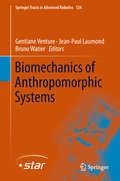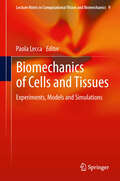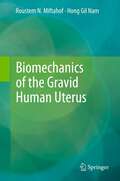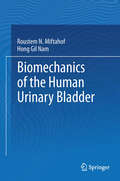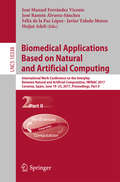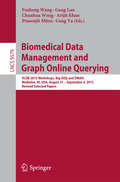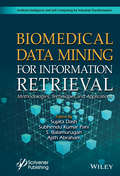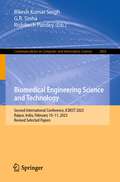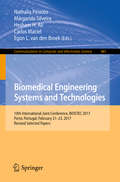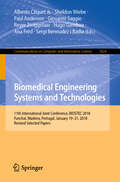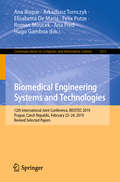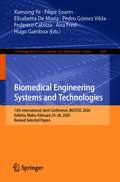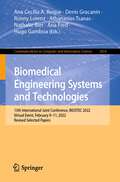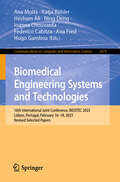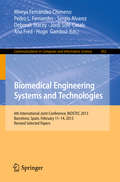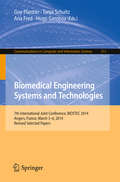- Table View
- List View
Biologically Inspired Cognitive Architectures: Proceedings of the First International Early Research Career Enhancement School on BICA and Cybersecurity (FIERCES 2017) (Advances in Intelligent Systems and Computing #636)
by Alexei V. Samsonovich Valentin V. KlimovThis book presents cutting-edge research focused on current challenges towards the realization of Biologically Inspired intelligent agents, or Cognitive Architectures (BICA). The chapters are written by both world-recognized experts (including Antonio Chella, Olivier Georgeon, Oliver Kutz, Antonio Lieto, David Vernon, Paul Verschure, and others) and young researchers. Together, they constitute a good mixture of new findings with tutorial-based reviews and position papers, all presented at the First International Early Research Career Enhancement School on Biologically Inspired Cognitive Architectures (FIERCES on BICA 2016), held April 21-24 in Moscow, Russia. Most works included here cross boundaries between disciplines: from neuroscience to social science, from cognitive science to robotics, and from bioengineering to artificial intelligence. A special emphasis is given to novel solutions to urgent problems that have been resisting traditional approaches for decades. Intended for providing readers with an update on biologically inspired approaches towards the computational replication of all the essential aspects of the human mind (the BICA Challenge), this book is expected to foster lively discussions on the topic and stimulate cross-disciplinary, cross-generation and cross-cultural collaboration.
Biologically Inspired Design: Computational Methods and Tools
by Robert B. Stone Daniel A Mcadams Ashok K GoelFrom simple cases such as hook and latch attachments found in Velcro to articulated-wing flying vehicles, biology often has been used to inspire many creative design ideas. The scientific challenge now is to transform the paradigm into a repeatable and scalable methodology. Biologically Inspired Design explores computational techniques and tools that can help integrate the method into design practice. With an inspiring foreword from Janine Benyus, Biologically Inspired Design contains a dozen chapters written by some of the leading scholars in the transdisciplinary field of bioinspired design, such as Frank Fish, Julian Vincent and Jeannette Yen from biology, and Amaresk Chakrabarti, Satyandra Gupta and Li Shu from engineering. Based in part on discussions at two workshops sponsored by the United States National Science Foundation, this volume introduces and develops several methods and tools for bioinspired design including: Information-processing theories, Natural language techniques, Knowledge-based tools, and Functional approaches and Pedagogical techniques. By exploring these fundamental theories, techniques and tools for supporting biologically inspired design, this volume provides a comprehensive resource for design practitioners wishing to explore the paradigm, an invaluable guide to design educators interested in teaching the method, and a preliminary reading for design researchers wanting to investigate bioinspired design.
Biologically Inspired Techniques in Many Criteria Decision Making: Proceedings of BITMDM 2021 (Smart Innovation, Systems and Technologies #271)
by Bhabani Shankar Prasad Mishra Satchidananda Dehuri Pradeep Kumar Mallick Sung-Bae ChoThis book includes best-selected, high-quality research papers presented at Second International Conference on Biologically Inspired Techniques in Many Criteria Decision Making (BITMDM 2021) organized by Department of Information & Communication Technology, Fakir Mohan University, Balasore, Odisha, India, during December 20-21, 2021. This proceeding presents the recent advances in techniques which are biologically inspired and their usage in the field of many criteria decision making. The topics covered are biologically inspired algorithms, nature-inspired algorithms, multi-criteria optimization, multi-criteria decision making, data mining, big-data analysis, cloud computing, IOT, machine learning and soft computing, smart technologies, crypt-analysis, cognitive informatics, computational intelligence, artificial intelligence and machine learning, data management exploration and mining, computational intelligence, and signal and image processing.
Biologically Inspired Techniques in Many Criteria Decision-Making: Proceedings of BITMDM 2024 (Learning and Analytics in Intelligent Systems #45)
by Satchidananda Dehuri Margarita Favorskaya Sujata Dash Ruppa K. Thulasiram Rohen H. SinghThis book includes selected high-quality research papers presented at 3rd International Conference on Biologically Inspired Techniques in Many Criteria Decision Making (BITMDM 2024) organized by School of Engineering and Technology, Nagaland University, Dimapur, India on 6th and 7th December 2024. This book presents the recent advances in techniques which are biologically inspired and their usage in the field of single and many criteria decision making. Further, the topics covered in this book are divided into different sections like: i) healthcare and biomedical applications, ii) security, fraud detection, and cybersecurity, iii) intelligent systems and decision support, iv) agriculture and environment, v) image processing and multi-media analysis, and vi) emerging technologies and applications.
Biologically Inspired Techniques in Many-Criteria Decision Making: International Conference on Biologically Inspired Techniques in Many-Criteria Decision Making (BITMDM-2019) (Learning and Analytics in Intelligent Systems #10)
by Bhabani Shankar Prasad Mishra Satchidananda Dehuri Margarita N. Favorskaya Pradeep Kumar Mallick Sung-Bae ChoThis book addresses many-criteria decision-making (MCDM), a process used to find a solution in an environment with several criteria. In many real-world problems, there are several different objectives that need to be taken into account. Solving these problems is a challenging task and requires careful consideration. In real applications, often simple and easy to understand methods are used; as a result, the solutions accepted by decision makers are not always optimal solutions. On the other hand, algorithms that would provide better outcomes are very time consuming. The greatest challenge facing researchers is how to create effective algorithms that will yield optimal solutions with low time complexity. Accordingly, many current research efforts are focused on the implementation of biologically inspired algorithms (BIAs), which are well suited to solving uni-objective problems. This book introduces readers to state-of-the-art developments in biologically inspired techniques and their applications, with a major emphasis on the MCDM process. To do so, it presents a wide range of contributions on e.g. BIAs, MCDM, nature-inspired algorithms, multi-criteria optimization, machine learning and soft computing.
Biologically Rationalized Computing Techniques For Image Processing Applications (Lecture Notes in Computational Vision and Biomechanics #25)
by Valentina Emilia Balas Jude HemanthThis book introduces readers to innovative bio-inspired computing techniques for image processing applications. It demonstrates how a significant drawback of image processing - not providing the simultaneous benefits of high accuracy and less complexity - can be overcome, proposing bio-inspired methodologies to help do so. Besides computing techniques, the book also sheds light on the various application areas related to image processing, and weighs the pros and cons of specific methodologies. Even though several such methodologies are available, most of them do not provide the simultaneous benefits of high accuracy and less complexity, which explains their low usage in connection with practical imaging applications, such as the medical scenario. Lastly, the book illustrates the methodologies in detail, making it suitable for newcomers to the field and advanced researchers alike.
Biomechanics in Medicine and Biology: Proceedings of the International Conference of the Polish Society of Biomechanics, Zielona Góra, Poland, September 5-7, 2018 (Advances in Intelligent Systems and Computing #831)
by Katarzyna Arkusz Romuald Będziński Tomasz Klekiel Szczepan PiszczatowskiThis book presents the proceedings of the “International Conference of the Polish Society of Biomechanics – BIOMECHANICS 2018” held in Zielona Góra, Poland from September 5 to 7, 2018, and discusses recent research on innovations in biomechanics.It includes a collection of selected papers in all key areas of biomechanics, including cellular, molecular, neuro and musculoskeletal biomechanics, as well as sport, clinical and rehabilitation biomechanics. These themes are extremely important in the development of engineering concepts and methods to provide new medical solutions, especially in the context of an ageing population.Presenting the latest technical advances and research methods used in clinical biomechanics, this book is of interest to scientists as well as junior researchers and students of interdisciplinary fields of engineering, medical, and sports sciences.
Biomechanics of Anthropomorphic Systems (Springer Tracts in Advanced Robotics #124)
by Jean-Paul Laumond Gentiane Venture Bruno WatierMechanical laws of motion were applied very early for better understanding anthropomorphic action as suggested in advance by Newton «For from hence are easily deduced the forces of machines, which are compounded of wheels, pullies, levers, cords, and weights, ascending directly or obliquely, and other mechanical powers; as also the force of the tendons to move the bones of animals». In the 19th century E.J. Marey and E. Muybridge introduced chronophotography to scientifically investigate animal and human movements. They opened the field of motion analysis by being the first scientists to correlate ground reaction forces with kinetics.Despite of the apparent simplicity of a given skilled movement, the organization of the underlying neuro-musculo-skeletal system remains unknown. A reason is the redundancy of the motor system: a given action can be realized by different muscle and joint activity patterns, and the same underlying activity may give rise to several movements. After the pioneering work of N. Bernstein in the 60’s on the existence of motor synergies, numerous researchers «walking on the border» of their disciplines tend to discover laws and principles underlying the human motions and how the brain reduces the redundancy of the system. These synergies represent the fundamental building blocks composing complex movements.In robotics, researchers face the same redundancy and complexity challenges as the researchers in life sciences. This book gathers works of roboticists and researchers in biomechanics in order to promote an interdisciplinary research on anthropomorphic systems at large and on humanoid robotics in particular.
Biomechanics of Cells and Tissues: Experiments, Models and Simulations (Lecture Notes in Computational Vision and Biomechanics #9)
by Paola LeccaThe application of methodological approaches and mathematical formalisms proper to Physics and Engineering to investigate and describe biological processes and design biological structures has led to the development of many disciplines in the context of computational biology and biotechnology. The best known applicative domain is tissue engineering and its branches. Recent domains of interest are in the field of biophysics, e.g.: multiscale mechanics of biological membranes and films and filaments; multiscale mechanics of adhesion; biomolecular motors and force generation. Modern hypotheses, models, and tools are currently emerging and resulting from the convergence of the methods and phylosophycal apporaches of the different research areas and disciplines. All these emerging approaches share the purpose of disentangling the complexity of organisms, tissues, and cells and mimiking the function of living systems. The contributions presented in this book are current research highlights of six challenging and representative applicative domains of phyisical, engineering, and computational approaches in medicine and biology, i.e tissue engineering, modelling of molecular structures, cell mechanics and cell adhesión processes, cancer physics, and physico-chemical processes of metabolic interactions. Each chapter presents a compendium or a review of the original results achieved by authors in the last years. Furthermore, the book also wants to pinpoint the questions that are still open and that could propel the future research.
Biomechanics of the Gravid Human Uterus
by Roustem N. Miftahof Hong Gil NamThe complexity of human uterine function and regulation is one of the great wonders of nature and represents a daunting challenge to unravel. This book is dedicated to the biomechanical modeling of the gravid human uterus and gives an example of the application of the mechanics of solids and the theory of soft shells to explore medical problems of labor and delivery. After a brief overview of the anatomy, physiology and biomechanics of the uterus, the authors focus mainly on electromechanical wave processes, their origin, dynamics, and neuroendocrine and pharmacological modulations. In the last chapter applications, pitfalls and problems related to modeling and computer simulations of the pregnant uterus and pelvic floor structures are discussed. A collection of exercises is added at the end of each chapter to help readers with self-evaluation. The book serves as an invaluable source of information for researchers, instructors and advanced undergraduate and graduate students interested in systems biology, applied mathematics and biomedical engineering.
Biomechanics of the Human Urinary Bladder
by Roustem N. Miftahof Hong Gil NamAs a research subject, the biomechanics of the urinary bladder are relatively young, yet medical problems associated with them are as old as mankind. Offering an update on recent achievements in the field, the authors highlight the underlying biological, chemical and physical processes of bladder function and present the systematic development of a mathematical model of the organ as a thin, soft biological shell. The book will be a valuable resource for postgraduate students and researchers interested in the applications of computational mathematics and solid mechanics to modern problems in biomedical engineering and medicine.
Biomedical Applications Based on Natural and Artificial Computing: International Work-Conference on the Interplay Between Natural and Artificial Computation, IWINAC 2017, Corunna, Spain, June 19-23, 2017, Proceedings, Part II (Lecture Notes in Computer Science #10338)
by Hojjat Adeli José Manuel Ferrández Vicente José Ramón Álvarez-Sánchez Félix de la Paz López Javier Toledo MoreoThe two volumes LNCS 10337 and 10338 constitute the proceedings of the International Work-Conference on the Interplay Between Natural and Artificial Computation, IWINAC 2017, held in Corunna, Spain, in June 2017. The total of 102 full papers was carefully reviewed and selected from 194 submissions during two rounds of reviewing and improvement. The papers are organized in two volumes, one on natural and artificial computation for biomedicine and neuroscience, addressing topics such as theoretical neural computation; models; natural computing in bioinformatics; physiological computing in affective smart environments; emotions; as well as signal processing and machine learning applied to biomedical and neuroscience applications. The second volume deals with biomedical applications, based on natural and artificial computing and addresses topics such as biomedical applications; mobile brain computer interaction; human robot interaction; deep learning; machine learning applied to big data analysis; computational intelligence in data coding and transmission; and applications.
Biomedical Data Analysis and Processing Using Explainable (Intelligent Systems Reference Library #222)
by Valentina E. Balas Deepak Gupta Ashish Khanna Aditya KhampariaThe book discusses Explainable (XAI) and Responsive Artificial Intelligence (RAI) for biomedical and healthcare applications. It will discuss the advantages in dealing with big and complex data by using explainable AI concepts in the field of biomedical sciences. The book explains both positive as well as negative findings obtained by explainable AI techniques. It features real time experiences by physicians and medical staff for applied deep learning based solutions. The book will be extremely useful for researchers and practitioners in advancing their studies.
Biomedical Data Management and Graph Online Querying: VLDB 2015 Workshops, Big-O(Q) and DMAH, Waikoloa, HI, USA, August 31 – September 4, 2015, Revised Selected Papers (Lecture Notes in Computer Science #9579)
by Fusheng Wang Gang Luo Chunhua Weng Arijit Khan Prasenjit Mitra Cong YuThis book constitutes the refereed proceedings of the two International Workshops on Big-Graphs Online Querying, Big-O(Q) 2015, and Data Management and Analytics for Medicine and Healthcare, DMAH 2015, held at Waikoloa, Hawaii, USA on August 31 and September 4, 2015, in conjunction with the 41st International Conference on Very Large Data Bases, VLDB 2015. The 9 revised full papers presented together with 5 invited papers and 1 extended abstract were carefully reviewed and selected from 22 initial submissions. The papers are organized in topical sections on information retrieval and data analytics for electronic medical records; data management and visualization of medical data; biomedical data sharing and integration; medical imaging analytics; and big-graphs online querying.
Biomedical Data Mining for Information Retrieval: Methodologies, Techniques, and Applications (Artificial Intelligence and Soft Computing for Industrial Transformation)
by Ajith Abraham Sujata Dash S. Balamurugan Subhendu Kumar PaniThis book comprehensively covers the topic of mining biomedical text, images and visual features towards information retrieval. Biomedical and Health Informatics is an emerging field of research at the intersection of information science, computer science, and health care and brings tremendous opportunities and challenges due to easily available and abundant biomedical data for further analysis. The aim of healthcare informatics is to ensure the high-quality, efficient healthcare, better treatment and quality of life by analyzing biomedical and healthcare data including patient's data, electronic health records (EHRs) and lifestyle. Previously it was a common requirement to have a domain expert to develop a model for biomedical or healthcare; however, recent advancements in representation learning algorithms allows us to automatically to develop the model. Biomedical Image Mining, a novel research area, due to its large amount of biomedical images increasingly generates and stores digitally. These images are mainly in the form of computed tomography (CT), X-ray, nuclear medicine imaging (PET, SPECT), magnetic resonance imaging (MRI) and ultrasound. Patients' biomedical images can be digitized using data mining techniques and may help in answering several important and critical questions related to health care. Image mining in medicine can help to uncover new relationships between data and reveal new useful information that can be helpful for doctors in treating their patients.
Biomedical Engineering Science and Technology: Second International Conference, ICBEST 2023, Raipur, India, February 10–11, 2023, Revised Selected Papers (Communications in Computer and Information Science #2003)
by G. R. Sinha Bikesh Kumar Singh Rishikesh PandeyThis CCIS post conference volume constitutes the proceedings of the Second International Conference, ICBEST 2023, in Raipur, India, in February 2023. The 32 full papers together in this volume were carefully reviewed and selected from 60 submissions. The conference's fundamental theme was "Computing in Biomedical Research". They were organized in three tracks as follows: Artificial Intelligence in Healthcare; Computational Mechanics in Healthcare and Health Informatics.
Biomedical Engineering Systems and Technologies: 10th International Joint Conference, Biostec 2017, Porto, Portugal, February 21-23, 2017, Revised Selected Papers (Communications In Computer And Information Science #881)
by Nathalia Peixoto Margarida Silveira Hesham H. Ali Carlos Maciel Egon L. van den BroekThis book constitutes the thoroughly refereed post-conference proceedings of the 10th International Joint Conference on Biomedical Engineering Systems and Technologies, BIOSTEC 2017, held in Porto, Portugal, in February 2017.The 20 revised full papers presented were carefully reviewed and selected from a total of 297 submissions. The papers are organized in topical sections on biomedical electronics and devices; bioimaging; bioinformatics models, methods and algorithms; bio-inspired systems and signal processing; and health informatics.
Biomedical Engineering Systems and Technologies: 11th International Joint Conference, BIOSTEC 2018, Funchal, Madeira, Portugal, January 19–21, 2018, Revised Selected Papers (Communications in Computer and Information Science #1024)
by Paul Anderson Reyer Zwiggelaar Ana Fred Hugo Gamboa Giovanni Saggio Alberto Cliquet Jr. Sheldon Wiebe Sergi Bermúdez i BadiaThis book constitutes the thoroughly refereed post-conference proceedings of the 11th International Joint Conference on Biomedical Engineering Systems and Technologies, BIOSTEC 2018, held in Funchal, Madeira, Portugal, in January 2018.The 25 revised full papers presented were carefully reviewed and selected from a total of 299 submissions. The papers are organized in topical sections on biomedical electronics and devices; bioimaging; bioinformatics models, methods and algorithms; health informatics.
Biomedical Engineering Systems and Technologies: 12th International Joint Conference, BIOSTEC 2019, Prague, Czech Republic, February 22–24, 2019, Revised Selected Papers (Communications in Computer and Information Science #1211)
by Ana Fred Hugo Gamboa Ana Roque Arkadiusz Tomczyk Elisabetta De Maria Felix Putze Roman MoucekThis book constitutes the thoroughly refereed post-conference proceedings of the 12th International Joint Conference on Biomedical Engineering Systems and Technologies, BIOSTEC 2019, held in Prague, Czech Republic, in February 2019.The 22 revised and extended full papers presented were carefully reviewed and selected from a total of 271 submissions. The papers are organized in topical sections on biomedical electronics and devices; bioimaging; bioinformatics models, methods and algorithms; bio-inspired systems and signal processing health informatics.
Biomedical Engineering Systems and Technologies: 13th International Joint Conference, BIOSTEC 2020, Valletta, Malta, February 24–26, 2020, Revised Selected Papers (Communications in Computer and Information Science #1400)
by Ana Fred Hugo Gamboa Federico Cabitza Elisabetta De Maria Xuesong Ye Filipe Soares Pedro Gómez VildaThis book constitutes extended and revised versions of the selected papers from the 13th International Joint Conference on Biomedical Engineering Systems and Technologies, BIOSTEC 2020, held in Valletta, Malta, in February 2020.The 29 revised and extended full papers presented were carefully reviewed and selected from a total of 363 submissions. The papers are organized in topical sections on biomedical electronics and devices; bioimaging; bioinformatics models, methods and algorithms; bio-inspired systems and signal processing; health informatic
Biomedical Engineering Systems and Technologies: 14th International Joint Conference, BIOSTEC 2021, Virtual Event, February 11–13, 2021, Revised Selected Papers (Communications in Computer and Information Science #1710)
by Ana Fred Hugo Gamboa Claudine Gehin Bruno Wacogne Alexandre Douplik Ronny Lorenz Bethany Bracken Cátia PesquitaThis book constitutes the refereed proceedings of the 14th International Joint Conference on Biomedical Engineering Systems and Technologies, BIOSTEC 2021, held virtually due to the COVID-19 crisis, in February 2021. The conference was held virtually due to the COVID-19 crisis.The 13 full papers included in this book were carefully reviewed and selected from 265 submissions. The papers selected to be included in this book contribute to the understanding of relevant trends of current research on Biomedical Engineering Systems and Technologies, including: Pattern Recognition and Machine Learning, Application of Health Informatics in Clinical Cases, Evaluation and Use of Healthcare IT, Medical Signal Acquisition, Analysis and Processing, Data Mining and Data Analysis, Decision Support Systems, e-Health, e-Health Applications, Mobile Technologies for Healthcare Applications and Medical Devices design.
Biomedical Engineering Systems and Technologies: 15th International Joint Conference, BIOSTEC 2022, Virtual Event, February 9–11, 2022, Revised Selected Papers (Communications in Computer and Information Science #1814)
by Ana Fred Hugo Gamboa Ronny Lorenz Athanasios Tsanas Ana Cecília A. Roque Denis Gracanin Nathalie BierThis book constitutes the refereed post-proceedings of the 15th International Conference on Biomedical Engineering Systems and Technologies, BIOSTEC 2022, held as a Virtual Event, during February 9–11, 2022. The 21 full papers included in this book were carefully reviewed and selected from 262 submissions. The papers selected to be included in this book contribute to the understanding of relevant trends of current research on Biomedical Engineering Systems and Technologies, including: Pattern Recognition and Machine Learning, Application of Health Informatics in Clinical Cases, Evaluation and Use of Healthcare IT, Medical Signal Acquisition, Analysis and Processing, Data Mining and Data Analysis, Decision Support Systems, e-Health, e-Health Applications, Mobile Technologies for Healthcare Applications and Medical Devices design.
Biomedical Engineering Systems and Technologies: 16th International Joint Conference, BIOSTEC 2023, Lisbon, Portugal, February 16–18, 2023, Revised Selected Papers (Communications in Computer and Information Science #2079)
by Ana Fred Hugo Gamboa Hesham Ali Ioanna Chouvarda Federico Cabitza Katja Bühler Ana Moita Ning DengThis book constitutes the refereed post-conference proceedings of the 16th International Joint Conference on Biomedical Engineering Systems and Technologies, BIOSTEC 2023, held in Lisbon, Portugal, during February 16-18, 2023. The 7 regular papers included in this book were carefully reviewed and selected from 246 submissions. They contribute to the understanding of relevant trends of current research on Biomedical Engineering Systems and Technologies, that include Pattern Recognition and Machine Learning, Decision Support Systems, Data Mining and Data Analysis, eHealth Applications, eHealth, Detection and Identification, Computational Intelligence, Cognitive Informatics, Big Data in Healthcare and Assistive Technologies.
Biomedical Engineering Systems and Technologies: 6th International Joint Conference, BIOSTEC 2013, Barcelona, Spain, February 11-14, 2013, Revised Selected Papers (Communications in Computer and Information Science #452)
by Jordi Solé-Casals Ana Fred Mireya Fernández-Chimeno Pedro L. Fernandes Sergio Alvarez Deborah Stacey Hugo GamboaThis book constitutes the thoroughly refereed post-conference proceedings of the 6th International Joint Conference on Biomedical Engineering Systems and Technologies, BIOSTEC 2013, held in Barcelona, Spain, in February 2013. The 28 revised full papers presented were carefully reviewed and selected from a total of 392 submissions. The papers cover a wide range of topics and are organized in four general topical sections on biomedical electronics and devices; bioinformatics models, methods and algorithms; bio-inspired systems and signal processing; health informatics.
Biomedical Engineering Systems and Technologies: 7th International Joint Conference, BIOSTEC 2014, Angers, France, March 3-6, 2014, Revised Selected Papers (Communications in Computer and Information Science #511)
by Ana Fred Hugo Gamboa Guy Plantier Tanja SchultzThis book constitutes the thoroughly refereed post-conference proceedings of the 7th International Joint Conference on Biomedical Engineering Systems and Technologies, BIOSTEC 2014, held in Angers, France, in March 2014. The 25 revised full papers presented were carefully reviewed and selected from a total of 362 submissions. The papers cover a wide range of topics and are organized in topical sections on biomedical electronics and devices; bioimaging; bioinformatics models, methods and algorithms; bio-inspired systems and signal processing; health informatics.
